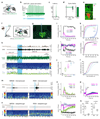A highly collateralized thalamic cell type with arousal-predicting activity serves as a key hub for graded state transitions in the forebrain
- PMID: 30349105
- PMCID: PMC6441588
- DOI: 10.1038/s41593-018-0251-9
A highly collateralized thalamic cell type with arousal-predicting activity serves as a key hub for graded state transitions in the forebrain
Abstract
Sleep cycles consist of rapid alterations between arousal states, including transient perturbation of sleep rhythms, microarousals, and full-blown awake states. Here we demonstrate that the calretinin (CR)-containing neurons in the dorsal medial thalamus (DMT) constitute a key diencephalic node that mediates distinct levels of forebrain arousal. Cell-type-specific activation of DMT/CR+ cells elicited active locomotion lasting for minutes, stereotyped microarousals, or transient disruption of sleep rhythms, depending on the parameters of the stimulation. State transitions could be induced in both slow-wave and rapid eye-movement sleep. The DMT/CR+ cells displayed elevated activity before arousal, received selective subcortical inputs, and innervated several forebrain sites via highly branched axons. Together, these features enable DMT/CR+ cells to summate subcortical arousal information and effectively transfer it as a rapid, synchronous signal to several forebrain regions to modulate the level of arousal.
Figures







References
-
- Halász P, Bódizs R. Dynamic Structure of NREM Sleep. Springer-Verlag; 2013.
-
- Terzano MG, Parrino L. Origin and Significance of the Cyclic Alternating Pattern (CAP). REVIEW ARTICLE. Sleep Med Rev. 2000;4:101–123. - PubMed
-
- Schieber JP, Muzet A, F P. Phases of spontaneous transitory activation during normal sleep in humans. Arch Sci Physiol. 1971;25:443–65. - PubMed
Publication types
MeSH terms
Grants and funding
LinkOut - more resources
Full Text Sources
Molecular Biology Databases

